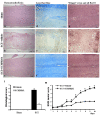Selective adenosine A2A receptor agonists and antagonists protect against spinal cord injury through peripheral and central effects
- PMID: 21486435
- PMCID: PMC3096915
- DOI: 10.1186/1742-2094-8-31
Selective adenosine A2A receptor agonists and antagonists protect against spinal cord injury through peripheral and central effects
Abstract
Background: Permanent functional deficits following spinal cord injury (SCI) arise both from mechanical injury and from secondary tissue reactions involving inflammation. Enhanced release of adenosine and glutamate soon after SCI represents a component in the sequelae that may be responsible for resulting functional deficits. The role of adenosine A2A receptor in central ischemia/trauma is still to be elucidated. In our previous studies we have demonstrated that the adenosine A2A receptor-selective agonist CGS21680, systemically administered after SCI, protects from tissue damage, locomotor dysfunction and different inflammatory readouts. In this work we studied the effect of the adenosine A2A receptor antagonist SCH58261, systemically administered after SCI, on the same parameters. We investigated the hypothesis that the main action mechanism of agonists and antagonists is at peripheral or central sites.
Methods: Spinal trauma was induced by extradural compression of SC exposed via a four-level T5-T8 laminectomy in mouse. Three drug-dosing protocols were utilized: a short-term systemic administration by intraperitoneal injection, a chronic administration via osmotic minipump, and direct injection into the spinal cord.
Results: SCH58261, systemically administered (0.01 mg/kg intraperitoneal. 1, 6 and 10 hours after SCI), reduced demyelination and levels of TNF-α, Fas-L, PAR, Bax expression and activation of JNK mitogen-activated protein kinase (MAPK) 24 hours after SCI. Chronic SCH58261 administration, by mini-osmotic pump delivery for 10 days, improved the neurological deficit up to 10 days after SCI. Adenosine A2A receptors are physiologically expressed in the spinal cord by astrocytes, microglia and oligodendrocytes. Soon after SCI (24 hours), these receptors showed enhanced expression in neurons. Both the A2A agonist and antagonist, administered intraperitoneally, reduced expression of the A2A receptor, ruling out the possibility that the neuroprotective effects of the A2A agonist are due to A2A receptor desensitization. When the A2A antagonist and agonist were centrally injected into injured SC, only SCH58261 appeared neuroprotective, while CGS21680 was ineffective.
Conclusions: Our results indicate that the A2A antagonist protects against SCI by acting on centrally located A2A receptors. It is likely that blockade of A2A receptors reduces excitotoxicity. In contrast, neuroprotection afforded by the A2A agonist may be primarily due to peripheral effects.
Figures









Similar articles
-
The selective adenosine A2A receptor agonist CGS 21680 reduces JNK MAPK activation in oligodendrocytes in injured spinal cord.Shock. 2009 Dec;32(6):578-85. doi: 10.1097/SHK.0b013e3181a20792. Shock. 2009. PMID: 19295488
-
Selective adenosine A(2a) receptor agonists reduce the apoptosis in an experimental model of spinal cord trauma.J Biol Regul Homeost Agents. 2010 Jan-Mar;24(1):73-86. J Biol Regul Homeost Agents. 2010. PMID: 20385073
-
The adenosine A2A receptor antagonist SCH58261 reduces macrophage/microglia activation and protects against experimental autoimmune encephalomyelitis in mice.Neurochem Int. 2019 Oct;129:104490. doi: 10.1016/j.neuint.2019.104490. Epub 2019 Jun 18. Neurochem Int. 2019. PMID: 31226280
-
Adenosine A2A receptor blockade attenuates excitotoxicity in rat striatal medium spiny neurons during an ischemic-like insult.Neural Regen Res. 2024 Feb;19(2):255-257. doi: 10.4103/1673-5374.375309. Neural Regen Res. 2024. PMID: 37488874 Free PMC article. Review.
-
Allosteric Modulation of Adenosine A2A Receptors as a New Therapeutic Avenue.Int J Mol Sci. 2022 Feb 14;23(4):2101. doi: 10.3390/ijms23042101. Int J Mol Sci. 2022. PMID: 35216213 Free PMC article. Review.
Cited by
-
Dual roles of the adenosine A2a receptor in autoimmune neuroinflammation.J Neuroinflammation. 2016 Feb 26;13:48. doi: 10.1186/s12974-016-0512-z. J Neuroinflammation. 2016. PMID: 26920550 Free PMC article.
-
Effects of hyperbaric oxygen on glucose-regulated protein 78 and c-Jun N-terminal kinase expression after spinal cord injury in rats.Int J Clin Exp Med. 2015 Mar 15;8(3):3309-17. eCollection 2015. Int J Clin Exp Med. 2015. PMID: 26064220 Free PMC article.
-
Intrathecal injection of adenosine 2A receptor agonists reversed neuropathic allodynia through protein kinase (PK)A/PKC signaling.Brain Behav Immun. 2013 Oct;33:112-22. doi: 10.1016/j.bbi.2013.06.004. Epub 2013 Jun 28. Brain Behav Immun. 2013. PMID: 23811314 Free PMC article.
-
Protective effect of ginkgolide B against acute spinal cord injury in rats and its correlation with the Jak/STAT signaling pathway.Neurochem Res. 2013 Mar;38(3):610-9. doi: 10.1007/s11064-012-0959-y. Epub 2012 Dec 29. Neurochem Res. 2013. PMID: 23274522
-
Role of Caspase-8 and Fas in Cell Death After Spinal Cord Injury.Front Mol Neurosci. 2018 Apr 3;11:101. doi: 10.3389/fnmol.2018.00101. eCollection 2018. Front Mol Neurosci. 2018. PMID: 29666570 Free PMC article. Review.
References
-
- Hagg T, Oudega M. Degenerative and spontaneous regenerative processes after spinal cord injury. J Neurotrauma. 2006;23:264–280. - PubMed
Publication types
MeSH terms
Substances
LinkOut - more resources
Full Text Sources
Other Literature Sources
Medical
Research Materials
Miscellaneous

